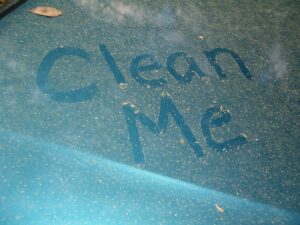 After seeing so many heartbreaking stories in Facebook allergy support groups recently, I wanted to choose a topic today that will help as many people as possible as quickly as possible. One of the most important things to consider when trying to stop reactions in their tracks is to consider contamination and allergen exposure routes. Dust made a nice title, and dust is part of this, but it goes so much further than just dust. Exposure to allergens (and chemicals) happens through three main entry points:
After seeing so many heartbreaking stories in Facebook allergy support groups recently, I wanted to choose a topic today that will help as many people as possible as quickly as possible. One of the most important things to consider when trying to stop reactions in their tracks is to consider contamination and allergen exposure routes. Dust made a nice title, and dust is part of this, but it goes so much further than just dust. Exposure to allergens (and chemicals) happens through three main entry points:
- Absorption – the allergen is absorbed through the skin, either because you touched something with traces of the allergen on it or because the allergen was airborne and contacted some part of you, whether it be your skin, eyes, sinuses, or something else. This is the most likely to be the main reaction with a new chemical sensitivity.
- Inhalation – the allergen was airborne and you breathed it in. It went into your trachea/lungs and caused breathing problems, usually through an immediate reaction.
- Ingestion – a little tougher. The allergen made contact with your food or drink (or was a part of your food or drink) and you ate or drank it.
When trying to eliminate a chemical from your environment, think about what parts of you are reacting. What can come into contact with those parts of your body? Read ingredient lists and look for safer, fragrance-free alternatives, as the single word “fragrance” can mean any combination of thousands of unnamed chemicals. The primary (most common) hit list for immediate relief:

- Your hand soap and body wash: Try switching to a pure bar soap with no added fragrance, like pure olive oil soap. Avoid using hand sanitizer, as it can contain methylisothiazolinone or other sensitizing chemicals.
- Your laundry detergent: Any cloth items you wash in it that touch you, including hand towels, bath towels, face cloths, clothing, bed sheets, blankets, and throws, should be rewashed in a simpler detergent or soap, or at least given extra hot water rinses, if possible.
- Body and face lotion: Try using a pure carrier oil, like jojoba oil, oat oil, sweet almond oil, hemp oil, coconut oil, rice bran oil, apricot kernel oil, or some combination of these. Rice bran oil by itself will dry the skin, so use in combination with a more moisturizing oil.
- Dish soap
- Vacuum all soft surfaces using a vacuum with a HEPA filter
 One of the toughest but most necessary steps is to get your whole household on board with you. If people in your house continue to wash their hands using hand soaps that cause you to react, then you all use the same towel to dry your hands or even touch the same bathroom doorknob, it can cause chemicals to be transferred to your hands. If you clean your room with safe cleaners but the rest of your household uses other cleaning agents, you will be in contact with those chemicals on a regular basis. Even dust from everyone else’s toilet paper in the air and all over surfaces in your bathroom can cause a reaction if you’re sensitive enough.
One of the toughest but most necessary steps is to get your whole household on board with you. If people in your house continue to wash their hands using hand soaps that cause you to react, then you all use the same towel to dry your hands or even touch the same bathroom doorknob, it can cause chemicals to be transferred to your hands. If you clean your room with safe cleaners but the rest of your household uses other cleaning agents, you will be in contact with those chemicals on a regular basis. Even dust from everyone else’s toilet paper in the air and all over surfaces in your bathroom can cause a reaction if you’re sensitive enough.
Outside your house, you have almost no control. You can request certain reasonable changes be made in places where you spend a lot of time, but there will always be at least some doubt about whether the space around you is free of the allergens that will cause you grief. Take your own things (soap, sheets, towels, toilet paper, etc) with you as much as you can. Wash or at least rinse your hands frequently and avoid touching your face. Avoid places with strong scents. Be conscious of possible exposures from hugging or shaking hands, and try to wash when you can.
No matter what, removing the allergen from your person as soon as possible after exposure is the best way to reduce chances of a reaction. Washing, sinus rinses, and changing clothing are all good steps. Most situations can at least be improved, even if you don’t have a firm diagnosis yet.
There are so many things you need to change when you find out you have a chemical allergy. What was the first thing you changed? Comment below.
Come back Monday for safer (and easy) laundry soap recipes.

With your scientific background I wonder if you can explain the relationship between contact allergies and food allergies? For example, when I was patch tested to prove the contact allergy to MI, I also reacted quite strongly to ‘sulphites’. Does this mean I would be allergic to sulphites in food? It seems not, as I am able to tolerate small quantities of wine and dried apricots, both of which contain sulphites. But more than a glass of wine will trigger a migraine, and I’m wondering if it is actually the ‘allergen’ that is the cause……?
That’s a very tough question, Jane. It is of concern to me, too, because I am allergic to propylene glycol, which in addition to being found in many lotions and topical medications can also be found in small quanitities in artificial flavours and colours. In fact, I asked something similar of my allergist, and he was unable to provide a clear answer. What he did tell me was that it was possible for me to have a food-related allergy to something for which the patch test was positive, but that a food challenge was the best way to diagnose it. He said he was unable to give me any sort of in-office test for food allergy unless my reaction was anaphyalxis.
Searching online didn’t bring much more clarity, but I did find that most food reactions are immediate, except if the reaction to the food is eczema, in which case the reaction can be delayed up to six hours. I also know that the stomach can be less sensitive (or more sensitive) to many things, which is why pollen up the nose can cause reaction while eating the pollen that has landed on your food during a picnic can be fine. Cooking foods also changes the nature of the allergens, and can reduce or remove reactivity.
If you are experiencing a food reaction to sulfites, it sounds like you are allergic (by way of doing your own food challenge), but your tolerance is such that you can handle small quantities. With that knowledge in hand you should be able to navigate the world of food a little easier. I’m sorry I can’t provide a definitive answer, but it sounds like the medical world isn’t much clearer on this.
Yes, I have found his a very difficult area. I don’t think I have a food allergy actually, have no trouble with anything I eat really (though I don’t eat any junk) but something triggers the occasional migraine and I cannot work out what it is. I actually think it is more down to air pressure changes, or underlying Lyme disease than anything I am eating. It’s complicated!!!!
Upon further evidence, I know there is definitely a connection possible between skin allergies and food allergies, even if it is only that one can develop into the other. My recent post about developing anaphylaxis to a contact allergen can be found here:
http://www.defaulttonature.com/2017/02/06/became-allergic-natural-artificial-flavours-colours/